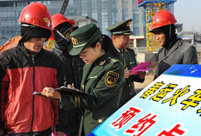 'Jin' named the word of the year by cross-strait netizens
'Jin' named the word of the year by cross-strait netizens Chinese scientific expedition goes to build new Antarctica station
Chinese scientific expedition goes to build new Antarctica station
 Chinese naval escort fleet conducts replenishment in Indian Ocean
Chinese naval escort fleet conducts replenishment in Indian Ocean 17th joint patrol of Mekong River to start
17th joint patrol of Mekong River to start China's moon rover, lander photograph each other
China's moon rover, lander photograph each other Teaming up against polluters
Teaming up against polluters
BEIJING, Dec. 20 (Xinhua) -- Friday's air is chilly but clear in Beijing, a city which all too frequently luxuriates under a blanket of smog.
Air pollution is only one of the symptoms of the imperfect growth model which favored GDP growth over every other factor, including environmental benefit.
In pursuit of a new kind of urbanization, the Chinese government is taking a green path.
At the end of 2012, China had 710 million urban residents. Its urban/rural ratio had increased from 17.9 percent in 1978 to 52.6 percent.
Urbanization with the correct objectives will not only stimulate domestic demand and improve social equality, but will benefit global economic growth and the environment.
A conference of urbanization which has just finished made it clear that China must promote eco-friendly progress, which means low-carbon growth and minimizing damage to nature.
Zhang Zhanbin, a professor with the Chinese Academy of Governance (CAG), told Xinhua on Friday of the importance of balance in the environment.
"An important message from the meeting is the progress on the environment and urbanization must come together. Protecting ecology must be an intimate part of urbanizing," Zhang said.
Smog is the most visible demonstration of the need for environmental progress. It is high time to clear up the historic debts of the bias toward GDP over environmental protection, according to Zhang.
Environmental protection must become central to both urban production and urban lifestyles, he added.
Pan Jiahua, director of the Institute of Urban and Environmental Studies at the Chinese Academy of Social Sciences, warns of falling back into old habits, with people damaging the environment and in turn being punished by nature.
Unrestricted expansion of cities, especially large cities, must be prevented to avoid pollution and overuse of resources, Pan said.
The conference statement also suggested curbing expansion saying that not all cities need to become megacities
In the past, local governments have favored large-scale construction, as local finances rely heavily on revenue from land sales, mostly for real estate development.
Pan also believes that China should also accelerate reform of the industrial structure. Fast growth has resulted in overcapacity in many sectors, such as steel, aluminum and cement.
"The previous growth pattern failed to take space and environmental capacity of cities into consideration," he said.
Ding Yuanzhu, a researcher with the CAG, agrees that economic restructuring and upgrade must be prioritized. The traditional pattern of urban development led by real estate construction needs to be abandoned and one that pursues comfortable working and living conditions put in its place, he said.
Confronted with unbalanced distribution of water, land and population, urbanization must be sustainable to prevent an ecological crisis in overcrowded cities, according to Ding.
 People prepare for upcoming 'Chunyun'
People prepare for upcoming 'Chunyun'  Highlights of Beijing int'l luxury show
Highlights of Beijing int'l luxury show Record of Chinese expressions in 2013
Record of Chinese expressions in 2013 China's moon rover, lander photograph each other
China's moon rover, lander photograph each other 17th joint patrol of Mekong River to start
17th joint patrol of Mekong River to start Spring City Kunming witnesses snowfall
Spring City Kunming witnesses snowfall Heritage of Jinghu, arts of strings
Heritage of Jinghu, arts of strings Weekly Sports Photos
Weekly Sports Photos PLA elite units unveiled
PLA elite units unveiled  China's stealth fighters hold drill over plateau
China's stealth fighters hold drill over plateau Chinese navy hospital ship's mission
Chinese navy hospital ship's mission  "Free lunch" program initiated in NW China
"Free lunch" program initiated in NW China  Rime scenery in Mount Huangshan
Rime scenery in Mount Huangshan DPRK's Kaesong Industrial Complex
DPRK's Kaesong Industrial Complex 'Jin' named the word of the year
'Jin' named the word of the year Day|Week|Month